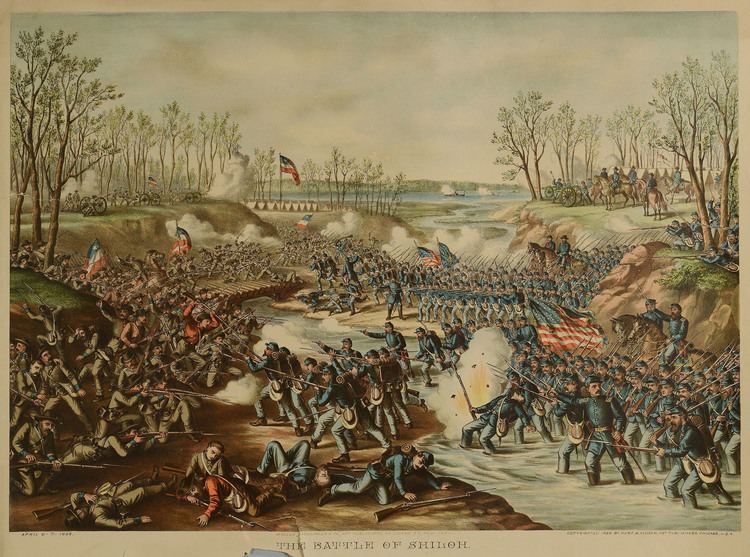Status Defunct Publication types Prints | Country of origin United States Distribution national Founded 1880 | |
 | ||
Founders Alexander Allison, Louis Kurz | ||
Kurz and allison
Kurz and Allison were a major publisher of chromolithographs in the late 19th century. Based at 267-269 Wabash Avenue in Chicago, they built their reputation on large prints published in the mid-1880s depicting battles of the American Civil War. This was a period of recollection among veterans, and the company was trying to capitalise of this sentiment. In all, a set of thirty-six battle scenes were published from designs by Louis Kurz (1835–1921), himself a veteran of the war. Kurz, a native of Salzburg, Austria, had emigrated to the United States in 1848. While the prints were highly inaccurate and considered naive fantasies like Currier and Ives prints, they were still sought after. They did not pretend to mirror the actual events but rather attempted to tap people's patriotic emotions. When the Spanish–American War broke out in 1898, the company created several large prints of the major battles and of the subsequent campaign of the Philippine–American War. Later conflicts such as the Russo-Japanese War were also illustrated by the company.
Contents
Formation of the firm
Louis Kurz first worked as a lithographer in Milwaukee, together with Henry Sifert. After the Civil War, he was one of the founders of the Chicago Lithographing Company. He worked there until the company was destroyed in the Great Chicago Fire of 1871. He then returned to Milwaukee, and started the American Oleograph Company. He moved back to Chicago in 1878, where in 1880 he became a partner in the newly founded firm of Kurz and Allison. Alexander Allison probably provided financial backing.
Civil War print series
In 1884 Kurz and Allison published a single print of the battle of Gettysburg inspired by Paul Philippoteaux's popular cyclorama on the same subject, and probably intended to profit by the popularity of the cyclorama. (The cyclorama was first exhibited in Chicago in 1883, where Kurz then was living.) According to Neely and Holzeer (2000) "The influence of the Gettysburg cyclorama on the Kurz and Alison print is readily recognizable. … The print openly copied vignettes from the painting and in at least one instance perpetuated a historical error ..."
In June 1886 Louis Prang published a series of prints under the title Prang's War Pictures. (They may well have been available for purchase individually some months earlier.) Shortly thereafter Kurz and Allison reissued their print of the Battle of Gettysburg and designed and issued additional prints in the same format (28 by 22 inches). Three such prints were issued in 1886, three in 1887, seven in 1888, six in 1889, four in 1890, six in 1891, one in 1891, four in 1892, and one in 1893. According to Neely and Holzeer (2000) Kurz and Alison, although inspired by Prang's work, did not imitate his artistic aspirtions. "Kurz and Alison remained true to the popular tradition in lithography embodied in the work of Currier and Ives; Prang was aiming higher." Neely and Holzeer (2000) emphasize Kurz and Allison's "antiphotographic" adherence to the traditions of popular lithography and the artistic styles of Civil War publications, in contrast to Prang's more modern style.
Several of the Kurz and Alison Civil War prints featured Black soldiers, particularly Storming Fort Wagner (1890) and The Fort Pillow Massacre (1893), which was unusual at the time.
Other work
Kurz and Allison also issued a series of "family prints" which showed such Civil War figures as Jefferson Davis, Abraham Lincoln, Ulysses S. Grant, and James A Garfield in domestic settings, surrounded by their families. At least one lithograph entitled "George Washington at Mount Vernon" (1889) is known to exist depicting George Washington, Martha Washington and Martha's two children.
The firm also produced a sizable number of black and white lithographs on religious subjects. These were marketed to localized communities with ethnic identities, often separated from their compatriots, often in the West. Many of the firm's prints were reproduced in New Mexican tinwork.
Later reputation
"Prints depicting the Civil War battles by Kurz and Allison are among the most sought after collectibles of Civil War enthusiasts." according to the Martin Art Gallery, Muhlenberg College. In spite of their lack of historical accuracy, Kurz and Allison prints (or details from them) are still used as book covers and iconic images of the Civil War.
